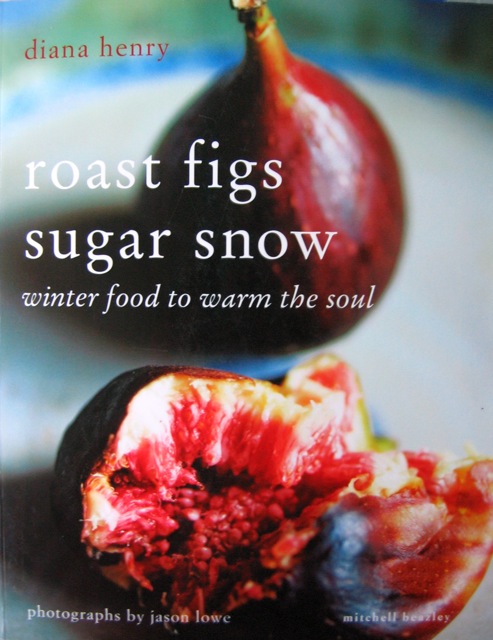
feature-image, l
(article, Diana Henry)
[%pageBreakSettings nobreak=true][%adInjectionSettings noInject=true] h3. From the chapter "From Bush and Bog: Cranberries, Blackberries, Sloes, and Rose Hips" It is a freezing October in Massachusetts, and everywhere I look there are scarlet lakes surrounded by trees glowing with autumnal foliage. The beauty of cranberries, Christmas-red and smooth as beads, ebbing and flowing in blue, flooded bogs, is mesmerizing. My eyes can barely cope with the color. [[block(sidebar). h1.Featured recipes]] "I love cranberry bogs when they're filled with water," says Irene Sorenson, who takes care of many of the cranberry farmers in this state, one of the biggest growing areas. "They are so romantic: irregularly shaped, curvaceous, organic." Cranberry growers — and there are only about a thousand of them worldwide — talk about their crop with love. Most of them are fifth- or sixth-generation and have berries in their blood. At this time of year, when the harvest is in full swing, they work around the clock. Some rest only by grabbing a bit of shuteye under a tree in the woods near the bogs; they will not leave their precious fruit. In fact, most growers are so fond of cranberries that, despite their unalloyed tartness, you will see them throwing raw cranberries into the air and letting them fall into their mouths. The cranberry is an ancient berry, indigenous to North America and, since it formed part of the first Thanksgiving meal, is a potent symbol of American beginnings and survival. It's certainly a plucky little berry. The naturally waxy coating will keep it fresh for a good three months in the bottom of the fridge, and it's also cute and endlessly cheering. [%image feature-image float=right width=400 caption="A bowl of fresh cranberries."] The Native Americans ate cranberries fresh and used them in pemmican, a kind of energy bar made of preserved venison and fat. They also used the juice to dye blankets and feathers and made poultices from them, and a basket of cranberries often sat in the middle of meetings with different tribes as a sign of friendship and goodwill. When you look at the stacks of cranberries that arrive in our shops every Christmas, it's hard to believe they haven't always been this abundant. But at one time they only grew wild. People picked them from patches near their homes, just for themselves. Commercial cultivation of cranberries only started two centuries ago, and the berries were harvested "dry," picked with long wooden combs. It was a slow and backbreaking process. Nowadays most berries are harvested "wet." The bogs where they grow are flooded, and large machines with big whirling beaters, referred to as "egg beaters," are driven through the bogs and gently dislodge the berries from the vines. Because cranberries contain little air pockets, they immediately float to the surface of the water. They are then herded towards a pipe, in pools marbled in shades of crimson and salmon pink. As most berries are destined for juice or sauce, it doesn't matter that they get so wet, but fruit to be sold fresh is still dry-harvested, collected by machines that look like large lawn mowers. [[block(sidebar). h1. About the book and author Originally published in the U.K. in 2005, Roast Figs, Sugar Snow is the result of Diana Henry's travels around Europe and North America, collecting recipes for wintertime foodstuffs ranging from venison and mushrooms to quince and cream. Henry, the food columnist for the Sunday Telegraph magazine, has written several cookbooks and hosts a British television show about food. Copyright @ 2005, 2009 Diana Henry. Reprinted by permission of Octopus Books USA. ]] Sadly, cranberries suffer from being part of our Christmas celebrations. Once the decorations are down, we don't think about them until the following December. It's a crying shame, especially when our range of winter fruits is so limited. We could do with the cranberry's tartness and piercing color right into the spring, and they'll certainly keep that long, providing stunning sorbets and bringing bursts of flavor and brightness to crumbles, cobblers, tarts, cakes, and compotes (they are spectacular gently poached in a sugar syrup and mixed with slices of blood orange), right until the end of March. I don't just use these berries for desserts. Cranberry sauce is great with pork. Many of the cranberry pickers in Massachusetts are of Cape Verdean origin and celebrate the end of the harvest with a hog roast accompanied by cranberry sauce. Cranberry sauce is also a fine substitute for the lingonberry sauce that is eaten with Scandinavian meat dishes and easier to make since lingonberries are almost impossible to get hold of. Cranberries are a must for Russian cooking, too. There they are made into kissel (a fruit compote thickened with arrowroot), find their way into tarts, are steeped in vodka to make cranberry liqueur, and are mixed with horseradish to make a relish for beef. And the Finns love them. You can see them in the market in Helsinki, bobbing in barrels of water alongside the smaller lingonberries. Dried cranberries, always slightly sweetened, are available all year round, and they're perfect for bringing little nuggets of sweet-sour flavor to wild-rice salads. So, the cranberry isn't just for Christmas. Buy them, freeze them, or stash them somewhere cool, and enjoy their tart fruitiness right into the spring.

feature-image, l

featurette-image, l

reference-image, l

newsletter-image, l

promo-image, l